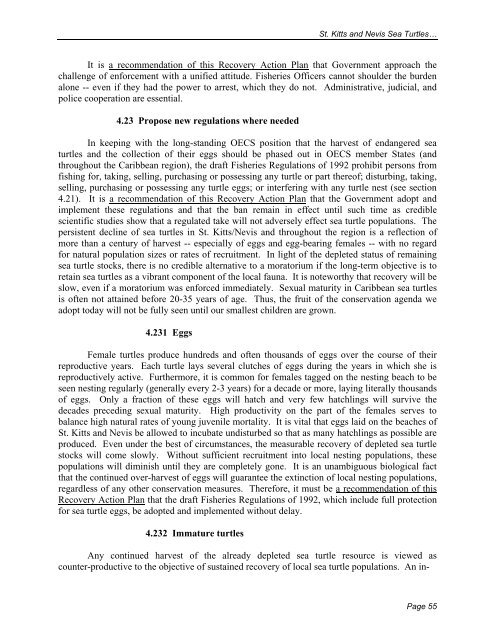Sea Turtle Recovery Action Plan for St. Kitts and Nevis - WIDECAST
Sea Turtle Recovery Action Plan for St. Kitts and Nevis - WIDECAST
Sea Turtle Recovery Action Plan for St. Kitts and Nevis - WIDECAST
You also want an ePaper? Increase the reach of your titles
YUMPU automatically turns print PDFs into web optimized ePapers that Google loves.
<strong>St</strong>. <strong>Kitts</strong> <strong>and</strong> <strong>Nevis</strong> <strong>Sea</strong> <strong>Turtle</strong>s…<br />
It is a recommendation of this <strong>Recovery</strong> <strong>Action</strong> <strong>Plan</strong> that Government approach the<br />
challenge of en<strong>for</strong>cement with a unified attitude. Fisheries Officers cannot shoulder the burden<br />
alone -- even if they had the power to arrest, which they do not. Administrative, judicial, <strong>and</strong><br />
police cooperation are essential.<br />
4.23 Propose new regulations where needed<br />
In keeping with the long-st<strong>and</strong>ing OECS position that the harvest of endangered sea<br />
turtles <strong>and</strong> the collection of their eggs should be phased out in OECS member <strong>St</strong>ates (<strong>and</strong><br />
throughout the Caribbean region), the draft Fisheries Regulations of 1992 prohibit persons from<br />
fishing <strong>for</strong>, taking, selling, purchasing or possessing any turtle or part thereof; disturbing, taking,<br />
selling, purchasing or possessing any turtle eggs; or interfering with any turtle nest (see section<br />
4.21). It is a recommendation of this <strong>Recovery</strong> <strong>Action</strong> <strong>Plan</strong> that the Government adopt <strong>and</strong><br />
implement these regulations <strong>and</strong> that the ban remain in effect until such time as credible<br />
scientific studies show that a regulated take will not adversely effect sea turtle populations. The<br />
persistent decline of sea turtles in <strong>St</strong>. <strong>Kitts</strong>/<strong>Nevis</strong> <strong>and</strong> throughout the region is a reflection of<br />
more than a century of harvest -- especially of eggs <strong>and</strong> egg-bearing females -- with no regard<br />
<strong>for</strong> natural population sizes or rates of recruitment. In light of the depleted status of remaining<br />
sea turtle stocks, there is no credible alternative to a moratorium if the long-term objective is to<br />
retain sea turtles as a vibrant component of the local fauna. It is noteworthy that recovery will be<br />
slow, even if a moratorium was en<strong>for</strong>ced immediately. Sexual maturity in Caribbean sea turtles<br />
is often not attained be<strong>for</strong>e 20-35 years of age. Thus, the fruit of the conservation agenda we<br />
adopt today will not be fully seen until our smallest children are grown.<br />
4.231 Eggs<br />
Female turtles produce hundreds <strong>and</strong> often thous<strong>and</strong>s of eggs over the course of their<br />
reproductive years. Each turtle lays several clutches of eggs during the years in which she is<br />
reproductively active. Furthermore, it is common <strong>for</strong> females tagged on the nesting beach to be<br />
seen nesting regularly (generally every 2-3 years) <strong>for</strong> a decade or more, laying literally thous<strong>and</strong>s<br />
of eggs. Only a fraction of these eggs will hatch <strong>and</strong> very few hatchlings will survive the<br />
decades preceding sexual maturity. High productivity on the part of the females serves to<br />
balance high natural rates of young juvenile mortality. It is vital that eggs laid on the beaches of<br />
<strong>St</strong>. <strong>Kitts</strong> <strong>and</strong> <strong>Nevis</strong> be allowed to incubate undisturbed so that as many hatchlings as possible are<br />
produced. Even under the best of circumstances, the measurable recovery of depleted sea turtle<br />
stocks will come slowly. Without sufficient recruitment into local nesting populations, these<br />
populations will diminish until they are completely gone. It is an unambiguous biological fact<br />
that the continued over-harvest of eggs will guarantee the extinction of local nesting populations,<br />
regardless of any other conservation measures. There<strong>for</strong>e, it must be a recommendation of this<br />
<strong>Recovery</strong> <strong>Action</strong> <strong>Plan</strong> that the draft Fisheries Regulations of 1992, which include full protection<br />
<strong>for</strong> sea turtle eggs, be adopted <strong>and</strong> implemented without delay.<br />
4.232 Immature turtles<br />
Any continued harvest of the already depleted sea turtle resource is viewed as<br />
counter-productive to the objective of sustained recovery of local sea turtle populations. An in-<br />
Page 55
















